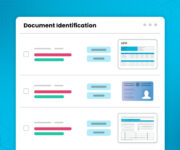Lenders often seek bank statements to verify prospective customers’ income, cash flow, or assets for loan disbursement. Unfortunately, PDF versions of bank statements can be tampered with or even entirely fabricated.
For instance, a Google search on ‘make a fake statement’ will open up dozens of websites that create a wholly fabricated bank statement with any numbers you desire.
Alternatively, fraudsters can start with a real bank statement and adjust the text using PDF editing software like Adobe Acrobat Pro to change the numbers, payees, and totals to indicate more revenue and cash flows.
According to research, 5% of all loan application documents submitted through an online channel have been tampered with. Furthermore, fake documents for loans result in a 60% loan write-off rate. Loan write-offs are directly associated with document manipulation.
This guide will look into ways lenders can significantly reverse the chances of falling for fake documents while lending.
What Is Document Fraud?
Document fraud is the fabrication, duplication, counterfeiting, and forgery of official documents to circumvent legal authorities and checks or attain unfair eligibility for something.
An unauthorised financial transaction involving documents might result in the loss of clients’ trust and increased follow-up expenditures. Because fraudsters are clever with their forgeries, rules-based fraud detection systems prove ineffectual.
Ways Perpetrators Usually take to Fake Documents
Unsurprisingly, the perpetrators usually do everything to avoid being caught after committing fraud. According to Report to the Nation 2020, there are four main ways to conceal fraud.
These methods involve documents, such as fabricating full physical and electronic papers or altering portions of documents’ contents. According to research undertaken by the 2021 Breach Report Data, over 2000 papers were publicly acknowledged to be fabricated, resulting in projected losses of $3.86 million.
Here are some standard methods used by fraudsters to fake documents:
1. Modifying the document
A modified document is altered in some way. The fraudsters can alter or remove information from the document. For example, they may add a false signature or stamp to the original document and a photograph. Blank, stolen documents can also be classified as modified documents, in which blank documents are replaced with incorrect information.
2. Creating a new document
New documents are replicas or imitations of original documents, just like counterfeit money. Typically, fraudsters order illegal documents with fictitious information or imitate publicly available document samples.
There are numerous samples of government-issued IDs and other legal documents available in public domains such as the internet. These documents are stolen, and particular information is inserted to make them appear authentic. Another feature of counterfeit documents is fictitious names for the company or authority issuing the document.
3. Identity theft
This fraud is frequently associated with fabricated documents, such as identity-related electronic documents.
The documents presented/shown are genuine; however, they are brought or represented by individuals who are not the legal owners of the papers.
What is the Traditional Way of Identifying Fake Documents?
The human eye is an old method of detecting document manipulation. Text style, space, alignment, and colour inconsistencies are easily detectable by the human eye.
A fraud analyst will also examine the metadata attributes for suspicious evidence of manipulation, such as the use of PDF editing software such as photoshop or the use of an untrusted document author.
For instance, the human eye and metadata analysis were once the only methods of identifying document forgery. In 5-10 minutes, a well-trained analyst could comprehensively examine a single document.
Here are some traditional ways of identifying a fake document:
1. Checking obvious errors
This one may appear simple; look for obvious errors—some fraudsters aren’t very talented and could make simple errors. It might be anything from a simple misspelling to typeface inconsistencies.
2. Look for unusual formatting
Another easy mistake to identify is odd formatting or text that appears blurrier than the rest of the paper. For example, if you scan a document into a computer and then edit it, the altered text will almost always seem different from the original text.
3. Check documents to official databases
A more time-consuming method of determining whether a document is genuine is to compare it to an official database. Some nations will have an official database accessible to lenders where they can check the validity of identification documents. This will undoubtedly take longer than a typical check, but it will verify that you are combating fraudsters.
What are the problems with the old way of identifying fake documents?
Manual document checks are still in use today. On the other hand, traditional techniques of checking are insufficient because there is a margin for human mistakes.
For instance, checking for spelling and grammar problems, irregular fonts and typefaces, and blurred text are apparent signs of fake documents. The human eye can also spot strange font formatting.
However, such inconsistencies become harder to track when working with large amounts of documents. Detecting fraudulent instances requires document fraud detection software that uses automated procedures for analysing and verifying the structure of information and visual details.
How to Identify Fake Documents Digitally?
Here are some ways lenders and banks can identify fake documents digitally:
1. Microscopic scanners
You can check for texture and data inconsistency analysis using microscopic scanners to help identify fake documents, including blank stolen and forged documents.
An advanced microscopic scanner for data integrity analysis helps detect the density and texture of the fonts in a document. For instance, if the ink’s density and texture are inconsistent, the document has been tampered with.
2. Advanced visual authentication technique
Advanced visual authentication techniques will aid in the detection of counterfeit, sample or compromised and camouflaged documents by scanning certain security features, watermarks, and stamps.
Counterfeiting original identity is usually done during the customer onboarding KYC step. Therefore, instead of hastening the onboarding process, if the onboarding software scans documents for specified security features, it will be evident that these documents are fake.
Using visual document authenticity techniques to look for specific security information can help detect typeface inconsistencies, digital tampering such as modified ID images or tampered pixels, etc.
Lenders can identify these forgeries using advanced visual document authentication techniques and compare them to a list of authorised countries, states, issuing authorities, etc.
3. Live identity verification
Lenders can prevent frauds committed with illegally obtained documents and imposter documents by utilising live identity verification tools and selfie photos or live video chat.
The Bottom Line
Since banks and NBFCs deal with KYC and onboarding information, fake documents incidents are prevalent. For various reasons, documents are falsified, and this can cost global economies billions of dollars. However, lenders can fight back against document fraud with the right technology.
Finezza’s lending and onboarding solutions, when combined with a bank statement analyser, can assist institutions in detecting fraud or fraudulent documents and taking the appropriate preventative actions.
Finezza’s document identification framework can help you validate documents such as Aadhar cards, bank statements, GST returns, cheques, photographs, balance sheets, etc., and tag all data points along the way. It also allows for automated data extraction without user involvement, which speeds up the entire process.
Contact Finezza today and learn how you can prevent the submission of fraudulent documents and validate your loan applicant’s lending profile.




Leave a Reply